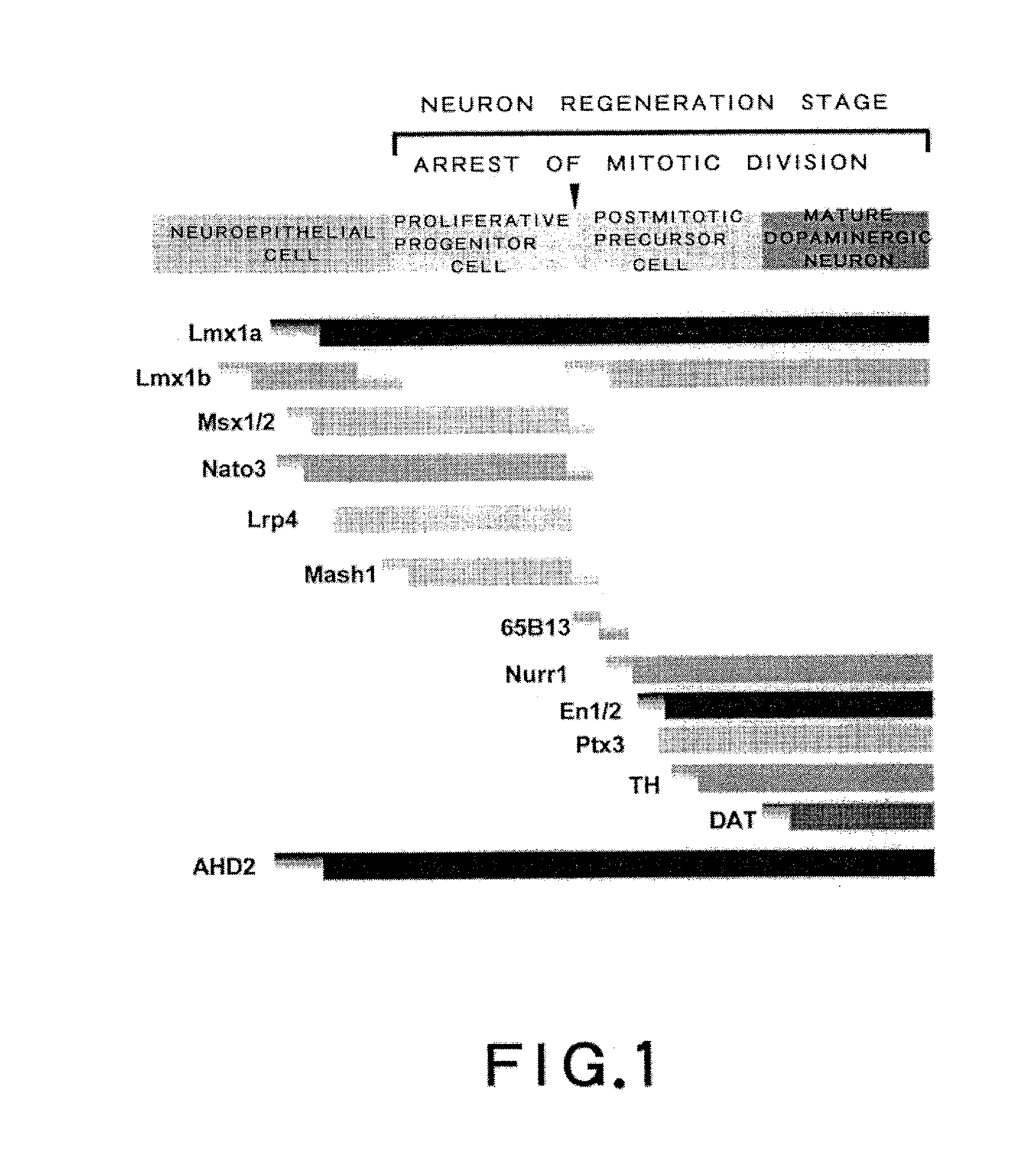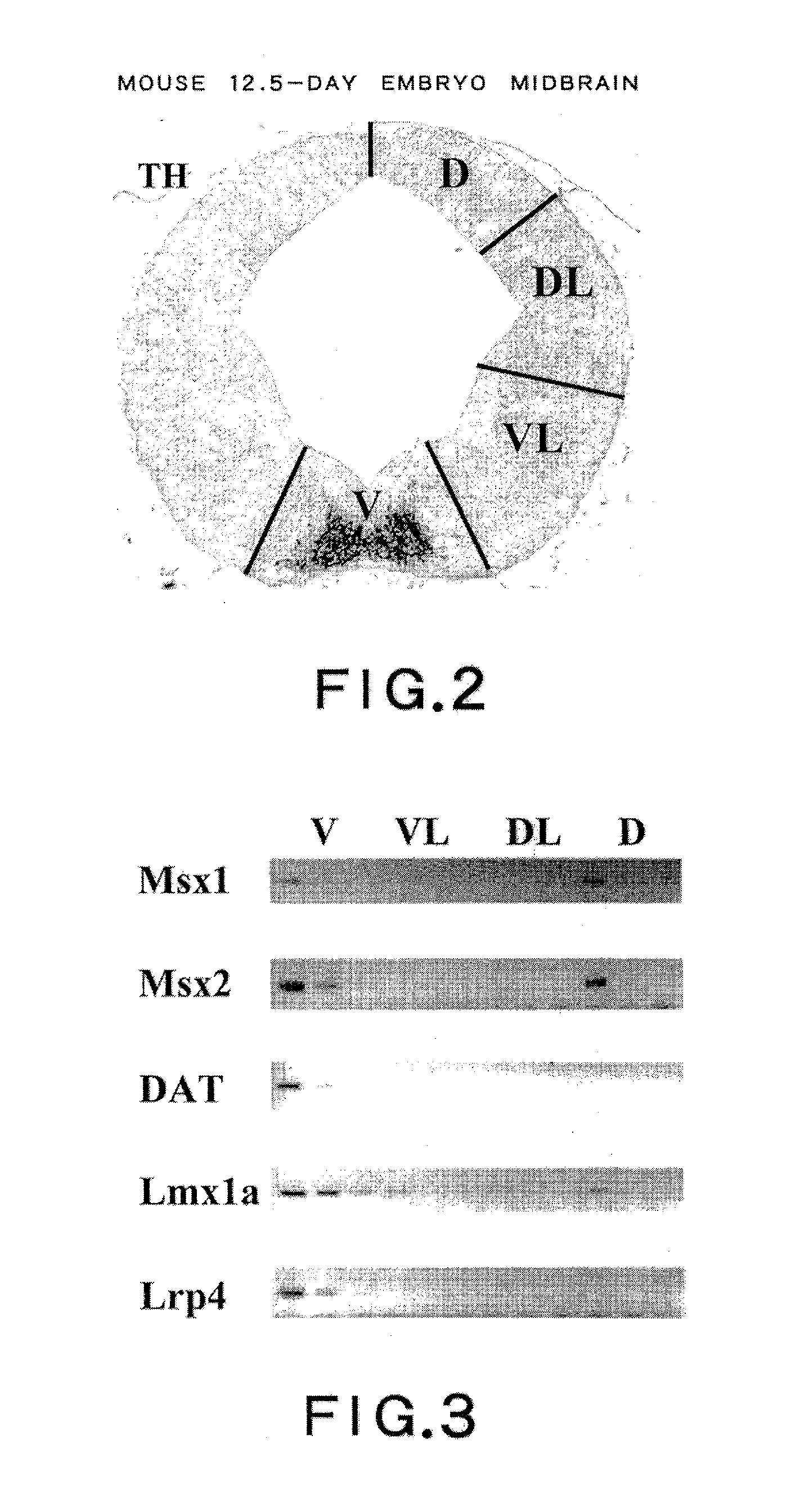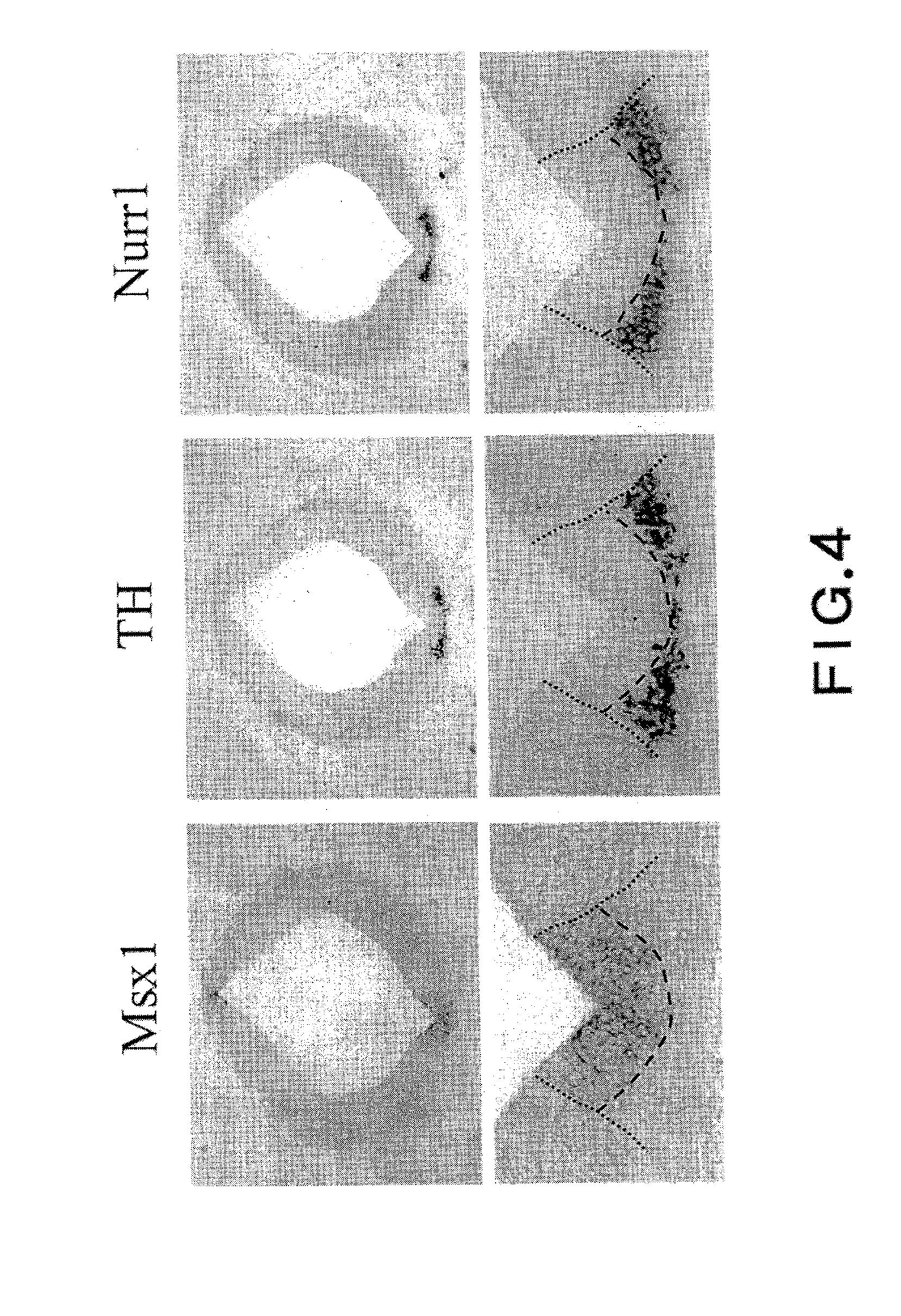DOPAMINERGIC NEURON PROLIFERATIVE PROGENITOR CELL MARKER Msx1/2
a technology of dopaminergic neurons and progenitor cells, applied in the field of msx1 gene and msx2 gene, can solve the problems of poor effect, progenitor cells can differentiate into nonuniform cell populations, and none of these contain only dopaminergic neurons or cells, so as to promote the application of regenerative medicin
- Summary
- Abstract
- Description
- Claims
- Application Information
AI Technical Summary
Benefits of technology
Problems solved by technology
Method used
Image
Examples
example 1
Expression Analysis of Msx1 Gene and Msx2 Gene
(1) Analysis by RT-PCR Method
[0217]In order to confirm that an Msx1 gene and an Msx2 gene are expressed in the cells of dopaminergic neuron lineage, expressions of mRNAs of Msx1, Msx2, DAT, Lmx1a, and Lrp4 in each region of a mouse embryonic midbrain were investigated by a RT-PCR method according to the following protocol. Here, DAT is a marker gene of the dopaminergic neuron (Development. 2004; 131(5):1145-55.), Lmx1a is a marker gene of dopaminergic neurons and dopaminergic neuron precursor cells (WO2005 / 052190), and Lrp4 is a marker gene of the dopaminergic neuron proliferative progenitor cells (WO2004 / 065599).
[0218]From a 12.5-day mouse (obtained from SLC) embryo, 4 regions (V region: most ventral region, VL region: ventral lateral region, DL region: dorsal lateral region, and D region: most dorsal region) of the midbrain shown in FIG. 2 were cut out, and the total RNA was prepared by using a RNeasy mini kit (Qiagen), and double-stra...
example 2
Expression Analysis of Msx1 Protein and Msx2 Protein
[0232]Next, by using anti-Msx1 / 2 antibodies (Developmental Studies Hybridoma Bank (http: / / www.uiowa.edu / ˜dshbwww / )), the expressions of Msx1 / 2 proteins were studied. Moreover, double staining by using an anti-Lmx1a antibody was performed.
[0233]An 11.5-day mouse embryo was excised and fixed for 2 hours at 4° C. by using 4% PFA (WAKO) / PBS (−), and then, the solution was replaced at 4° C. overnight by 20% sucrose (WAKO) / PBS (−) and then the embryo was embedded with OCT (Sakura Seiki Co., Ltd.). Sections of 12 μm thickness were prepared, mounted on slide glasses, dried for 30 minutes at room temperature, and then moistened again with PBS (−). Next, blocking (Blockase (Dainippon Sumitomo Pharma Co., Ltd.)) was performed for 30 minutes at room temperature, and then, reaction with a primary antibody (Developmental Studies Hybridoma Bank) was performed for one hour at room temperature, and then, reaction was further performed at 4° C. over...
example 3
Expressions of Msx1 Gene and Msx2 Gene in Dopaminergic Neurons Induced to Differentiate from ES Cells
[0236]Whether an Msx1 gene and an Msx2 gene are expressed when ES cells are induced to differentiate into dopaminergic neurons was studied.
[0237]First, according to the SDIA method (Kawasaki et al. Neuron. 2000 28(1):31-40.), ES cells (mouse CCE strain provided from Mr. Nishikawa in Riken CDB, Kawasaki et al. Neuron. 2000 28(1):31-40.) was induced to differentiate into dopaminergic neurons. The cells were collected after 4, 6, 8, 10, 12 days after the induction. The total RNA was prepared by using the RNeasy mini kit (Qiagen), and RT-PCR was performed. First, with respect to 1 μg of the total RNA, cDNA synthesis was performed by using the RNA PCR kit (TAKARA). By using the cDNAs corresponding to 10 ng, 1 ng, and 0.1 ng as templates, PCR was performed in the following reaction system.
10xExTaq2μl2.5 mM dNTP1.6μlExTaq0.1μl100 μM primer0.2μl for eachcDNA1μlDistilled water14.9μl
[0238]Afte...
PUM
| Property | Measurement | Unit |
|---|---|---|
| temperature | aaaaa | aaaaa |
| temperature | aaaaa | aaaaa |
| temperature | aaaaa | aaaaa |
Abstract
Description
Claims
Application Information
 Login to View More
Login to View More - R&D
- Intellectual Property
- Life Sciences
- Materials
- Tech Scout
- Unparalleled Data Quality
- Higher Quality Content
- 60% Fewer Hallucinations
Browse by: Latest US Patents, China's latest patents, Technical Efficacy Thesaurus, Application Domain, Technology Topic, Popular Technical Reports.
© 2025 PatSnap. All rights reserved.Legal|Privacy policy|Modern Slavery Act Transparency Statement|Sitemap|About US| Contact US: help@patsnap.com



